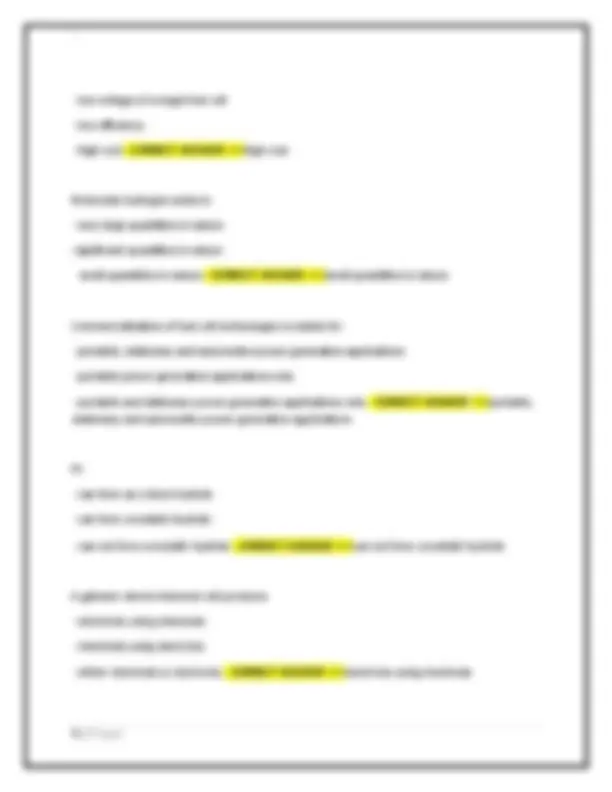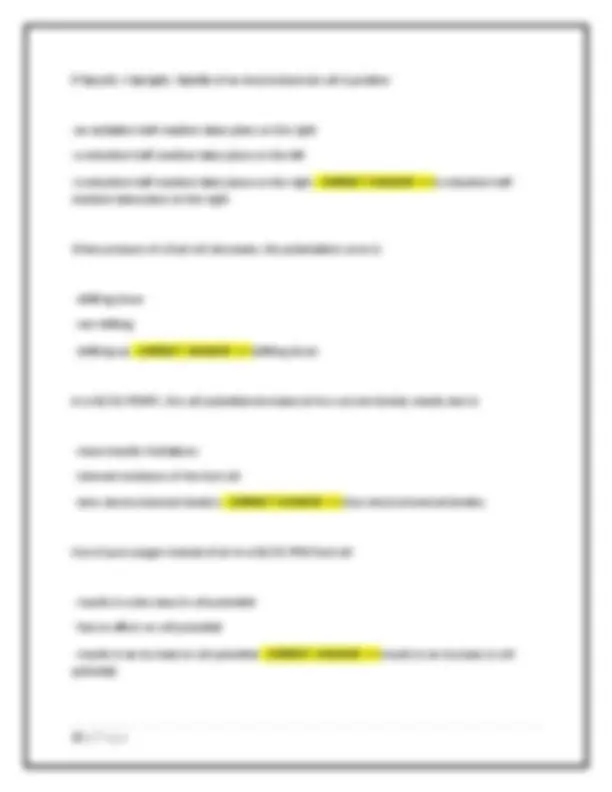Download EGEE 420 FINAL EXAM ACTUAL 200 QUESTIONS & CORRECT ANSWERS NEWEST UPDATE and more Exams Nursing in PDF only on Docsity!
EGEE 420 FINAL EXAM ACTUAL 200 QUESTIONS &
CORRECT ANSWERS NEWEST UPDATE
The carbon-to-hydrogen ratio in methane is 1: 1: 4:1 - CORRECT ANSWER >>> 1: A fuel cell generates electricity by
- directly combusting a fuel
- both of these
- electrochemically converting chemical energy - CORRECT ANSWER >>> electrochemically converting chemical energy The country that has pledged a carbon neutral economy is
- U.S.A.
- none of these
- Germany - CORRECT ANSWER >>> none of these Hydrogen bonds occur between molecules of HCl
- H2O
- CH4 - CORRECT ANSWER >>> H2O
If deuterium fuses with tritium, the nuclear reaction output will be
- neutron and helium
- neutron, helium, and energy
- only neutron - CORRECT ANSWER >>> neutron, helium, and energy Cost of the hydrogen production via water electrolysis using solar and wind power generation is
- high
- moderate
- low - CORRECT ANSWER >>> high One of the best options to make the power generation sustainable is the hydrogen
- production, storage and use
- production and storage
- production - CORRECT ANSWER >>> production, storage and use The main components of fuel and electrolytic cells are
- absolutely different
- quite similar
- quite different - CORRECT ANSWER >>> quite similar Methane is
Generally, fuel cells can be fueled by
- both of these
- CH H2 - CORRECT ANSWER >>> both of these Currently, the most valuable motivation for developing the hydrogen economy
- environmental
- economical
- political - CORRECT ANSWER >>> environmental Development of the hydrogen technology would need
- substantial government support
- minor government support
- no government support - CORRECT ANSWER >>> substantial government support The energy content of hydrogen per unit of weight has
- seven times of energy of coal
- three times the energy of gasoline
- both of these - CORRECT ANSWER >>> both of these One of the challenges for commercialization of fuel cells is
- low voltage of a single fuel cell
- low efficiency
- high cost - CORRECT ANSWER >>> high cost Molecular hydrogen exists in
- very large quantities in nature
- significant quantities in nature small quantities in nature - CORRECT ANSWER >>> small quantities in nature Commercialization of fuel cell technologies is mainly for
- portable, stationary and automotive power generation applications
- portable power generation applications only
- portable and stationary power generation applications only - CORRECT ANSWER >>> portable, stationary and automotive power generation applications Pt
- can form an s-block hydride
- can form a metallic hydride
- can not form a metallic hydride - CORRECT ANSWER >>> can not form a metallic hydride A galvanic electrochemical cell produces
- electricity using chemicals
- chemicals using electricity
- either chemicals or electricity - CORRECT ANSWER >>> electricity using chemicals
1.088 V
1.095 V
1.102 V - CORRECT ANSWER >>> 1.088 V
What is the standard electrode potential of the Zn/Zn2+ electrode? 1.104 V
- 0.762 V 0.342 V - CORRECT ANSWER >>> - 0.762 V In Nernst's equation the standard electrode potential depends
- on both of these
- on temperature
- on the concentration scales chosen for activities - CORRECT ANSWER >>> on both of these In a galvanic cell, the electric potential
- of the cathode is more positive than the electric potential of the anode
- of the cathode is the same as the electric potential of the anode
- of the anode is more positive than the electric potential of the cathode **- CORRECT ANSWER
** of the cathode is more positive than the electric potential of the anode Using the CRC Handbook data, calculate the standard electrode potential of the O2 gas electrode at 1.014 bar and 100 oC. 1.167 V
1.229 V
0.998 V - CORRECT ANSWER >>> 1.167 V
Using the CRC Handbook data, estimate the standard electrode potential (at 25 °C and 1. bar) of the oxygen gas electrode. 1.229 V 2.020 V 0.695 V - CORRECT ANSWER >>> 1.229 V H2(g) = 2 H+(aq) + 2 e- is
- a reduction reaction
- an oxidation reaction
- a combustion reaction - CORRECT ANSWER >>> an oxidation reaction A reduction process occurs at
- the cathode
- either the cathode or the anode
- the anode - CORRECT ANSWER >>> the cathode Using the CRC Handbook data, estimate the standard Gibbs energy, (ΔrG°) of reaction of decomposition of liquid water to gaseous hydrogen and oxygen at 25 °C and 1 bar. +237.141 kJ/mol 0 kJ/mol
- 237.141 kJ/mol - CORRECT ANSWER >>> +237.141 kJ/mol
- gathering of electrons in a half-reaction
- release of electrons in a half-reaction
- release of protons in a half-reaction - CORRECT ANSWER >>> release of electrons in a halfreaction Using the CRC Handbook data, calculate the standard electrode potential difference (E°) of a fuel cell, which consumes hydrogen and oxygen and produces gaseous water at 1000 K and 1 bar. 0.998 V 1.167 V 1.229 V - CORRECT ANSWER >>> 1.167 V The IUPAC convention is that the cell potential difference is
- either of these
- the left-hand potential minus the right-hand potential
- the right-hand potential minus the left-hand potential - CORRECT ANSWER >>> the righthand potential minus the left-hand potential What is the cell potential difference (E) of the Daniell cell (at 25 °C) if activities of Zn2+(aq) and Cu2+(aq) are, respectively, 0.1 and 0.01? 1.132 V 1.072 V 1.102 V - CORRECT ANSWER >>> 1.072 V The Daniell Cell's electrodes are
- redox electrodes
- metal/metal ion electrodes
- two gas electrodes - CORRECT ANSWER >>> metal/metal ion electrodes The galvanic cell anode is
- the positive electrode
- either positive or negative electrode
- the negative electrode - CORRECT ANSWER >>> the negative electrode Using Tafel equation, calculate the exchange current density at overpotential of +0.5 V and the current density of +0.1 A/cm2 if the transfer coefficient is 0.5 and temperature is 25 °C. 5.9410-6 A/cm 5.9410-4 A/cm 5.9410-5 A/cm2 - CORRECT ANSWER >>> 5.9410-6 A/cm The IUPAC recommendation is that the cathodic current is either positive or negative positive negative - CORRECT ANSWER >>> negative The two main contributions to an electrochemical reaction are
- electron (charge) transfer and adsorption/desorption
- electron (charge) transfer and mass transfer
- chemical reaction and adsorption/desorption - CORRECT ANSWER >>> electron (charge) transfer and mass transfer Current density is proportional to
- shifted to the right - CORRECT ANSWER >>> shifted to the left In the reaction profile, the activated complex is located at
- the potential energy minimum
- the potential energy maximum
- between the potential energy minimum and maximum - CORRECT ANSWER >>> the potential energy maximum In this course, the net current density is defined as
- cathodic current density - anodic current density
- anodic current density - cathodic current density
- anodic current density + cathodic current density - CORRECT ANSWER >>> anodic current density - cathodic current density When the exchange current density is 10-1A/cm2 the electrochemical reaction is
- electrochemically reversible
- electrochemically irreversible
- either reversible or irreversible - CORRECT ANSWER >>> electrochemically reversible If the exchange current density is 10-7 A/cm2, the electrochemical reaction is
- very fast
- slow
- fast - CORRECT ANSWER >>> slow The exchange current density is defined when there is
- no net current at an electrode
- zero overpotential
- both of these - CORRECT ANSWER >>> both of these Galvani potential difference is
- between the bulk of metal electrode and the bulk of solution
- between the outer Helmholtz plane and the bulk of solution
- between the outer Helmholtz plane and bulk of metal electrode **- CORRECT ANSWER
** between the bulk of metal electrode and the bulk of solution Based on the generalized Butler-Volmer equation, we can conclude that when the anodic current approaches its limiting value the overpotential goes to - minus infinity - plus infinity - zero - CORRECT ANSWER >>> plus infinity If the exchange current density is 10-2 A/cm2, the electrochemical reaction is - slow - very slow - fast - CORRECT ANSWER >>> fast Using Butler-Volmer equation, calculate the current density for hydrogen half-reaction at 25 °C and ovepotential of 30 mV if the exchange current density (jo) is 0.002 A/cm2 and the transfer coefficient (α) is 0.5. 0.0247 A/cm 0.247 A/cm
0.35 W/cm2 both of these **- CORRECT ANSWER
** both of these In the Daniell cell the copper metal bar is always a positive electrode.
True False - CORRECT ANSWER >>> true In the Daniell cell, the power is produced when the cell is in
- the equilibrium mode
- the galvanic mode
- the electrolytic mode - CORRECT ANSWER >>> the galvanic mode How to deal with the waste solutions after the Daniell Cell lab?
- should be collected in containers
- should be diluted and drained
- should be left in the lab as they are - CORRECT ANSWER >>> should be collected in containers The salt bridge in the Daniell Cell is for
- separating the electrode chambers
- conducting ions
- both of these - CORRECT ANSWER >>> both of these Using the electrolytic polarization plot shown in the figure estimate the decomposition potential and the internal resistance of a Daniell cell
- 1.2 V & 600 ohm
- 1.2 V & 300 ohm +1.2 V & 300 ohm - CORRECT ANSWER >>> - 1.2 V & 300 ohm Calculate the total charge passed in the Daniell cell during 20 min using the data given in the table: Time, min Current, mA 0 21 5 22 10 23 15 24 20 25 27.6 C 25.2 C 30.0 C - CORRECT ANSWER >>> 27.6 C The mode of cell operation shown in the lab video is
- all of these
- galvanic
- equilibrium
- electrolytic - CORRECT ANSWER >>> all of these
E = P i - CORRECT ANSWER >>> P = i E Calculate the theoretical cell potential of a Daniell cell (25 °C), which has copper electrode on the right and zinc electrode on the left. The molal concentrations of CuSO4(aq) and ZnSO4(aq) are, respectively, 0.1 and 1.0 mol/kg. Find and use the mean activity coefficients from CRC Handbook assuming that the individual activity coefficient of an ion equals the mean activity coefficient of the corresponding electrolyte. 1.102 V
- 1.102 V 1.088 V - CORRECT ANSWER >>> 1.088 V The three reasons for polishing the metal electrodes with sand paper before performing electrochemical measurements are to
- avoid an undesirable reaction
- provide safety
- remove the metal oxide layer
- remove the impurities
- provide faster measurement - CORRECT ANSWER >>> - avoid an undesirable reaction
- remove the metal oxide layer
- remove the impurities The instrument to use in the Daniell Cell lab for accurate measurement of the cell potential is
- power supply
- high impedance (resistance) electrometer ammeter **- CORRECT ANSWER
** high impedance (resistance) electrometer Calculate the mass of copper
dissolved during electrolysis in Daniell cell if the charge passed through the electrode is 30.62 C. 0.0101g 1.010 g 0.101g - CORRECT ANSWER >>> 0.0101g The reaction H2O(l) → (1/2) O2(g) + H2(g) takes place in
- an electrolytic cell
- a galvanic cell
- an equilibrium cell - CORRECT ANSWER >>> an electrolytic cell Arrange experimental procedures for the open circuit potential measurement. polishing electrodes weighing electrodes connecting electrochemical cell and electrometer assembling the cell - CORRECT ANSWER >>> 1,2,3,


























































